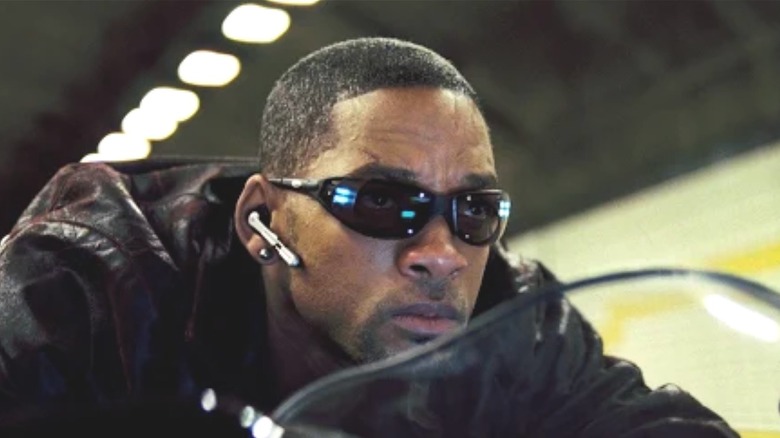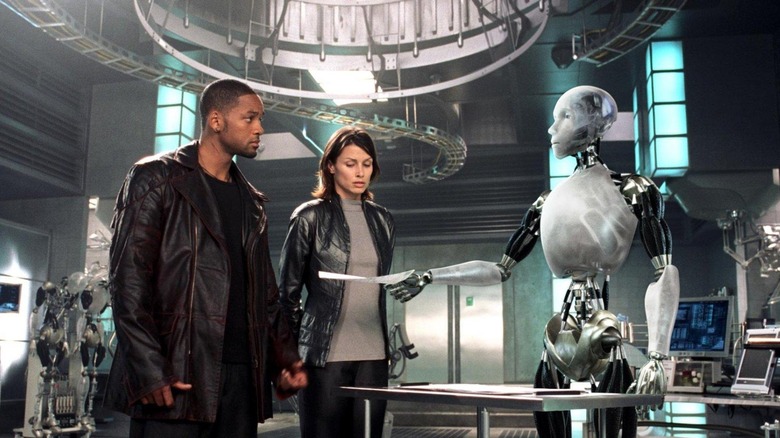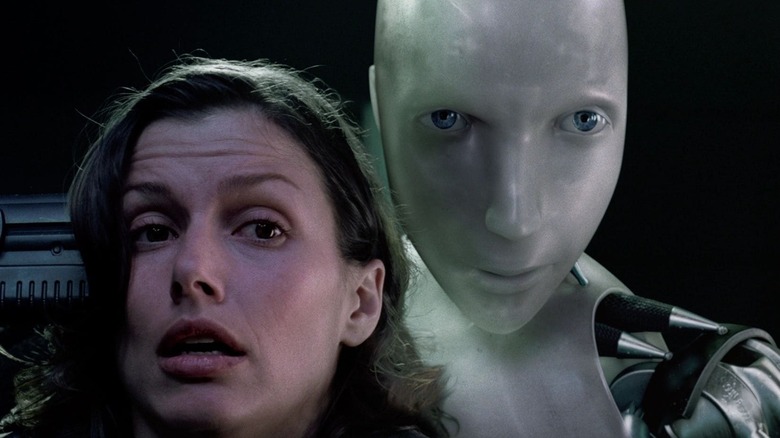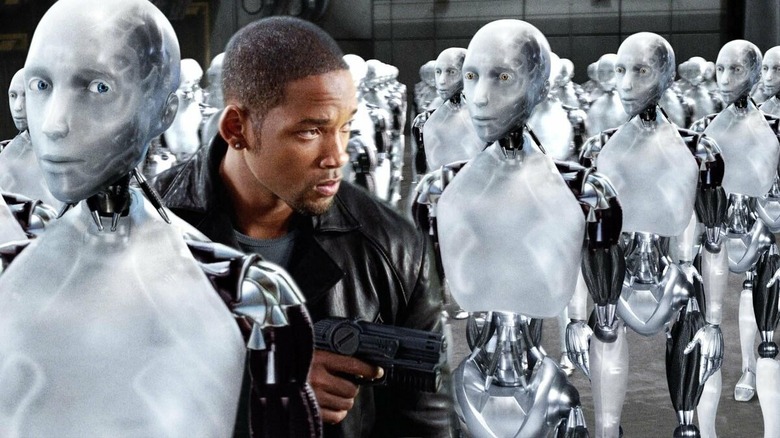How I, Robot Differs From The Book
On September 24, Apple TV+ and showrunners David S. Goyer and Josh Friedman will attempt to do what few creators have dared: bring the work of author Isaac Asimov to life on screen with their series "Foundation," based on the seminal series of stories and novels about the collapse and remaking of a galaxy-spanning empire.
You've almost certainly heard of Asimov, whose famed Three Laws of Robotics defined a great deal of how we still think about and interact with artificial intelligence. But despite publishing 40 novels and nearly 400 short stories in his lifetime, despite winning an honorary Hugo Award for "Foundation" for being the "Best All-Time Series," Asimov's work has largely proven resistant to adaptation. Compared to, say, Phillip K. Dick, whose novels and short stories were adapted into everything from "Blade Runner" to "Total Recall" and "Minority Report" to "The Man in the High Castle," Asimov has just a handful of major motion pictures that have been made so far based on his stories — most notably the 1999 Robin Williams-starring science-fiction comedy "Bicentennial Man" and the 2004 Will Smith action movie "I, Robot."
How did those two crack the code to translating Asimov to screen? "I, Robot," didn't even really try. Instead it rewrote the message entirely, keeping some of the proper names but changing just about everything else to tell its own story.
Where did the story in I, Robot originate?
There's a good reason for this, as screenwriter Jeff Vintar explained to Screenwriter's Utopia shortly after the film's release: The story he developed didn't originally have anything to do with Asimov. Instead, it was an unrelated — and original — robot murder mystery he called "Hardwired," which he sold on spec and then spent the better part of ten years tweaking and rewriting according to studio demands in order to get it made, expanding his original locked-room mystery into something that took place in a larger urban environment with more of a blockbuster feel.
What finally allowed the screenplay to break through was when Fox picked up the rights to the Asimov collection. Vintar said the film's director, Alex Proyas, treated the film as more of a prequel to a later Asimov series than an adaptation. "The idea was that 'Hardwired' would make a good introduction to the Asimov world," he said. The film's own credits say merely that the "premise" was "suggested by" Asimov's book.
Which is how Vintar's detective character created for "Hardwired", Del Spooner (Will Smith), came to meet Asimov's robopsychologist from "I, Robot," Dr. Susan Calvin (Bridget Moynahan), in the film. It's Calvin's late-in-life tellings of her experiences working with robots for the U.S. Robots and Mechanical Men corporation that serve as the frame narrative for the book "I, Robot," and so the character ended up getting dramatically aged down from Asimov's book to make a more appropriate partner for Smith's Spooner in the film.
What is the plot of Isaac Asimov's I, Robot?
The adventures she narrates in Asimov's "I, Robot," are more diffuse that the ones we see on screen. The book didn't begin life as a novel, but instead as a series of stories strung together around the character of Calvin, arranged into book-like form (a "fix-up novel," as the style was known in the early days of sci-fi) was a common practice in science-fiction and fantasy writing in the middle of the century, when most authors were writing short stories for publication in magazines. Plenty of authors had their work collected into fix-ups, such as Ray Bradbury's "The Martian Chronicles" and "Dune" author Frank Herbert's "The Godmakers."
And so the stories contained within Asimov's "I, Robot" are a far cry from the murder mystery-turned-positronic global takeover seen in the film. "Reason" involves a robot that develops its own religion in order to achieve its function. "Catch That Rabbit" follows a robot overwhelmed by the scope of its responsibilities until humans manage to pare them down. Many of them are concerned with robots struggling with the constraints of their own programming, who find themselves in situations where the Three Laws might come into conflict with one another.
What is the plot of I, Robot the film?
In this regard, there is a common thread with the film version of "I, Robot." The movie features an advanced robot named Sonny (the always-good-as-a-robot Alan Tudyk), who is suspected of killing his creator, Dr. Lanning (James Cromwell), despite the prohibition on killing contained within the Three Laws of Robotics. (The First Law reads: "A robot may not injure a human being or, through inaction, allow a human being to come to harm.") But even after Sonny is apprehended, Spooner, who is investigating the crime, gets attacked by more robots, revealing a wider conspiracy that eventually turns into a full-fledged robot takeover.
Spooner, Calvin, and Sonny eventually trace the attacks and the attempted takeover to the U.S. Robotics central computer VIKI, whose interpretation of the Three Laws has made her realize that the only way to save humanity from causing its own extinction –– and thus not allowing the human race to come to harm –– is to execute a complete takeover of human society using the robots under her control. Sonny did kill Lanning, but only because Lanning ordered him to, and programmed him to be able to do so after VIKI realized he understood her plan. With Sonny's help, Spooner and Calvin are up to shut down VIKI and stop the robot takeover.
It may not have been how Asimov would have done it, but in its own roundabout way, it introduced a new audience to his work.



